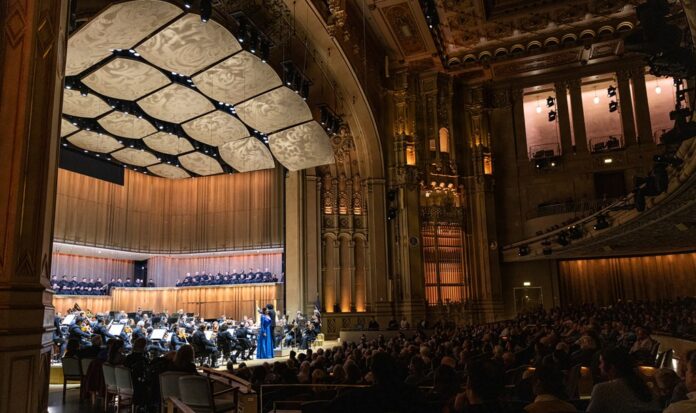On Saturday, the San Diego Symphony, under Music Director Rafael Payare’s baton, played Mahler’s Symphony No. 2, “Resurrection,” as their first season concert in the newly restored Jacobs Music Center.
The symbolism was inescapable.
For those believing in an afterlife where one is converted into higher being, that is what happened to the venue formerly known as Copley Symphony Hall: transformation and rebirth.
Modern teal seating replaces the old red movie-theater chairs. Floor seats have been reconfigured with new aisles and a parterre section with improved sightlines. The stage has three levels now, with aesthetically pleasing, organically shaped reflective panels high overhead and a fabric-like mesh wall behind the players.
Recessed into that wall above the percussion are seats to accommodate the 89 members of a new San Diego Symphony Festival Chorus. They were an indispensable component of Saturday’s concert, along with the dark luxurious beauty of mezzo-soprano Anna Larsson’s voice, and the rich, lustrous tones of soprano Angela Meade.

The gorgeous visual enhancements would mean little without the marvelous sonic transmutation that acoustician Paul Scarbrough and his team of renovators wrought on the hall.
It was all there to savor on Saturday: an increased dynamic range that permitted frightening fortissimos with hitherto unexperienced clarity and the quietest instrumental murmurs unimpeded by ambient hall noise.
Mahler’s Symphony No. 2 boldly juxtaposes these sounds, and Payare and company and — this cannot be emphasized enough — the redesigned Jacobs Music Center brilliantly delivered Mahler’s stormy and triumphant music to the near-capacity audience.
Some symphonies — say Mozart’s or Beethoven’s — pretty much perform themselves. Play what’s written on the page and you’re guaranteed at least a good concert experience. However, Mahler’s symphonies require generous interpretation or they don’t come to life.
Payare excels at injecting passion into the music, and on Saturday the give and take that he extracted from the orchestra made Mahler’s over-the-top score thrill.
He placed the second violins on the opposite side of the stage from the firsts. Mahler composed what would now be called stereo panning effects in the third movement, the melody thrown back and forth between first and second violins. The tempo was brisker than normally heard, making this strangely neurotic movement even more anxious.
The sense of direction of sounds in Jacobs Music Center is particularly acute now. This was put to excellent use, not only in the violin section effects, but also in the offstage music in the final movement.
Previously, an offstage trumpet simply sounded vaguely offstage. Now, you can hear where that offstage trumpet is — stage right or left — with surprising placement.
Opened lobby doors on either side of the house allowed brass bands to be heard with pinpoint accuracy — surround sound! The Festival Chorus, rehearsed with apparent care by Andrew Megill, came in on a beautiful pianissimo, and later exultantly delivered the last movement’s climaxes.
The living Austrian composer Thomas Larcher had a 20-minute long work, “Time,” on the program’s first half. Co-commissioned by the San Diego Symphony, we heard it two years ago at the Rady Shell, and its blending of competent middle-of-the-road nontonal music with what sounded like a pastiche of Dvorak or Tchaikovsky made as little sense on Saturday as it did then.
Opening for the grandiose catharsis of Mahler’s Second is tough for most composers. I suspect few audience members went home discussing Larcher. It was a curious beginning to what became a most memorable Mahler evening.



